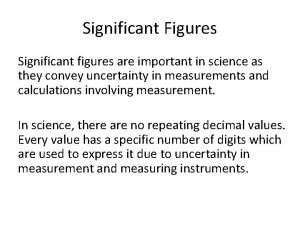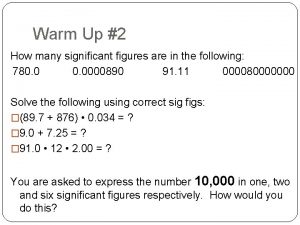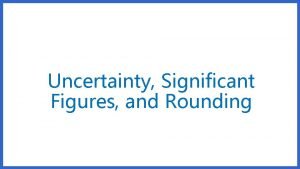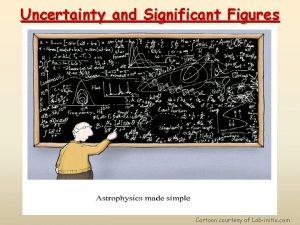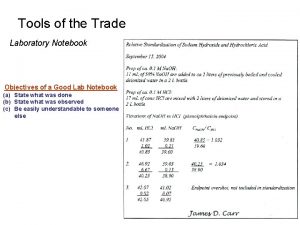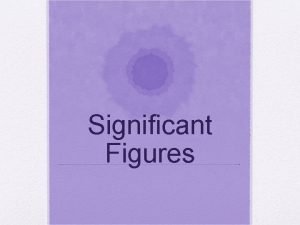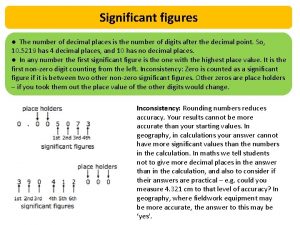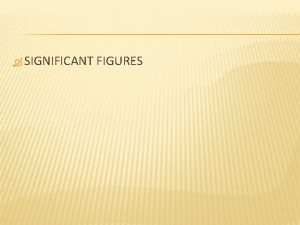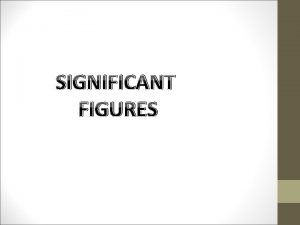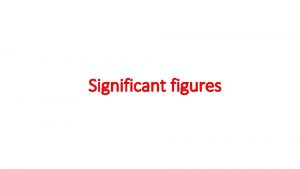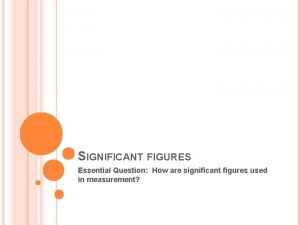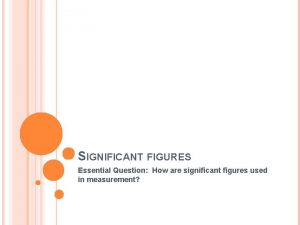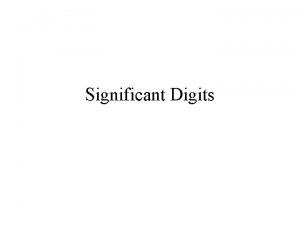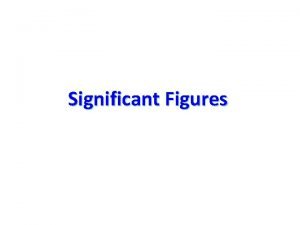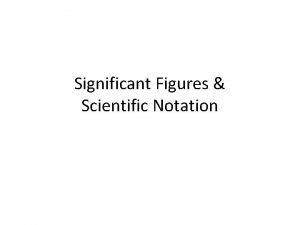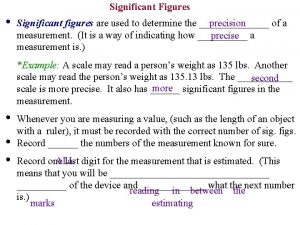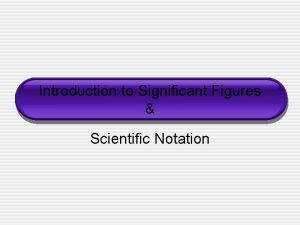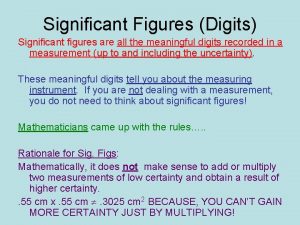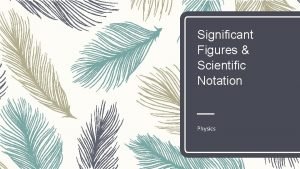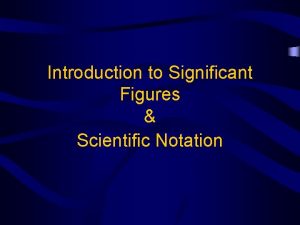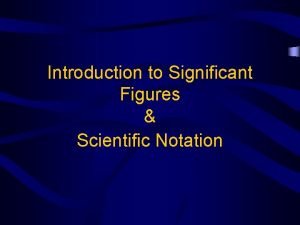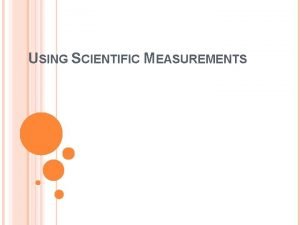Significant Figures Focus Question Why are significant figures



















- Slides: 19

Significant Figures

Focus Question Why are significant figures important?

New Vocabulary accuracy precision error percent error significant figures

Accuracy and Precision • Accuracy refers to how close a measured value is to an accepted value. • Precision refers to how close a series of measurements are to one another.

Error and Percent Error • Error is defined as the difference between an experimental value and an accepted value. • Percent error expresses error as a percentage of the accepted value.

CALCULATING PERCENT ERROR Use with Example Problem 5. Problem Use Student A’s density data in Table 3 (from slide 6) to calculate the percent error in each trial. Report your answers to two places after the decimal point. Response ANALYZE THE PROBLEM You are given the errors for a set of density calculations. To calculate percent error, you need to know the accepted value for density, the errors, and the equation for percent error. KNOWN UNKNOWN Accepted value for density = 1. 59 g/cm 3 Percent errors = ? Errors: − 0. 05 g/cm 3; 0. 01 g/cm 3; − 0. 02 g/cm 3

CALCULATING PERCENT ERROR EVALUATE THE ANSWER The percent error is greatest for Trial 1, which had the largest error, and smallest for Trial 2, which was closest to the accepted value.

Significant Figures • The precision of a measurement is indicated by the number of digits reported. The reported digits are called significant figures. • Significant figures include all known digits plus one estimated digit.

Significant Figures Rules for significant figures • Rule 1: Nonzero numbers are always significant. • Rule 2: Zeros between nonzero numbers are always significant. • Rule 3: All final zeros to the right of the decimal are significant. • Rule 4: Placeholder zeros are not significant. To remove placeholder zeros, rewrite the number in scientific notation. • Rule 5: Counting numbers and defined constants have an infinite number of significant figures.

SIGNIFICANT FIGURES SOLVE FOR THE UNKNOWN Rules 1, 2, and 3. Use with Example Problem 6. • Problem Count all nonzero numbers, zeros between nonzero numbers, and final zeros to the right of the decimal place. Determine the number of significant figures in the following masses. a. 0. 00040230 g b. 405, 000 kg Response ANALYZE THE PROBLEM You are given two measured mass values. Apply the appropriate rules to determine the number of significant figures in each value. • Rule 4. Ignore zeros that act as placeholders. a. 0. 00040230 g has five significant figures. b. 405, 000 kg has three significant figures. EVALUATE THE ANSWER One way to verify your answers is to write the values in scientific notation: 4. 0230 × 10 -4 g and 4. 05 × 105 kg. Without the placeholder zeros, it is clear that 0. 00040230 g has five significant figures and that 405, 000 kg has three significant figures.

Rounding Numbers Rules for Rounding • Rule 1: If the digit to the right of the last significant figure is less than 5, do not change the last significant figure. 2. 532 → 2. 53 • Rule 2: If the digit to the right of the last significant figure is greater than 5, round up the last significant figure. 2. 536 → 2. 54

Rounding Numbers Rules for Rounding • Rule 3: If the digits to the right of the last significant figure a 5 followed by a nonzero digit, round up the last significant figure. 2. 5351 → 2. 54 • Rule 4: If the digits to the right of the last significant figure a 5 followed by a 0 or no other number at all, look at the last significant figure. If it is odd, round it up; if it is even, do not round up. 2. 5350 → 2. 54 2. 5250 → 2. 52

Rounding Numbers Addition and subtraction • Round the answer to the same number of decimal places as the original measurement with the fewest decimal places. Multiplication and division • Round the answer to the same number of significant figures as the original measurement with the fewest significant figures.

ROUNDING NUMBERS WHEN ADDING Use with Example Problem 7. Problem SOLVE FOR THE UNKNOWN • A student measured the length of his lab partners’ shoes. If the lengths are 28. 0 cm, 23. 538 cm, and 25. 68 cm, what is the total length of the shoes? Response ANALYZE THE PROBLEM The three measurements need to be aligned on their decimal points and added. The measurement with the fewest digits after the decimal point is 28. 0 cm, with one digit. Thus, the answer must be rounded to only one digit after the decimal point. Align the measurements and add the values. 28. 0 cm 23. 538 cm + 25. 68 cm 77. 218 cm • Round to one place after the decimal; Rule 1 applies. The answer is 77. 2 cm. EVALUATE THE ANSWER The answer, 77. 2 cm, has the same precision as the least-precise measurement, 28. 0 cm.

ROUNDING NUMBERS WHEN MULTIPLYING Use with Example Problem 8. Calculate the volume of a book with the following dimensions: length = 28. 3 cm, width = 22. 2 cm, height = 3. 65 cm. Response ANALYZE THE PROBLEM Volume is calculated by multiplying length, width, and height. Because all of the measurements have three significant figures, the answer also will. KNOWN UNKNOWN Length = 28. 3 cm Volume = ? cm 3 Height = 3. 65 cm Calculate the volume, and apply the rules of significant figures and rounding. • Problem Width = 22. 2 cm SOLVE FOR THE UNKNOWN State the formula for the volume of a rectangle. Volume = length × width × height • Substitute values and solve. Volume = 28. 3 cm × 22. 2 cm × 3. 65 cm = 2293. 149 cm 3 • Round the answer to three significant figures. Volume = 2290 cm 3 EVALUATE THE ANSWER To check if your answer is reasonable, round each measurement to one significant figure and recalculate the volume. Volume = 30 cm × 20 cm × 4 cm = 2400 cm 3. Because this value is close to your calculated value of 2290 cm 3, it is reasonable to conclude the answer is correct.

Quiz 1. Which term is defined as the difference between an experimental value and an accepted value? A accuracy B precision C error D percent error CORRECT

Quiz 2. Significant figures reflect the ______ of a measurement. A accuracy B precision C error D percent error CORRECT

Quiz 3. Which of the following has 3 significant figures? A 7. 84 s CORRECT C 110 s B 0. 004 s D 121. 5 s

Quiz 4. What is 6. 950 g rounded to 2 significant figures? A 6. 95 g C 6. 9 g B 6. 96 g D 7. 0 g CORRECT
 Insidan region jh
Insidan region jh Pictures
Pictures Costa question levels
Costa question levels Why are significant figures important in science
Why are significant figures important in science Calculating significant figures
Calculating significant figures Prolepsis
Prolepsis Porter's competitive strategies
Porter's competitive strategies Business level strategy differentiation
Business level strategy differentiation Actor focus vs object focus
Actor focus vs object focus Tsunami questions
Tsunami questions What is the focus question
What is the focus question Question formulation technique
Question formulation technique Don't ask why why why
Don't ask why why why Science fiction often uses nautical analogies
Science fiction often uses nautical analogies Significant figures of 956
Significant figures of 956 What are uncertain digits
What are uncertain digits Sig figs
Sig figs Logarithm significant figures
Logarithm significant figures Atlantic pacific rule
Atlantic pacific rule What does significant figures mean in math
What does significant figures mean in math



